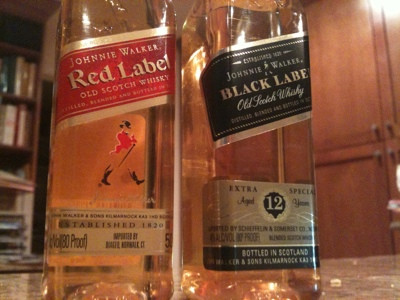Johnnie Walker stands as a giant in the world of blended Scotch whisky. For many, the iconic striding man logo is synonymous with Scotch itself. Within their diverse range, the Red Label and Black Label expressions are often the first points of entry. With a modest price gap, typically around $10-$15, the question naturally arises: is Johnnie Walker Black worth the upgrade from Red, or does Red Label hold its own as a budget-friendly Scotch? To explore this, we’ll dive deep into the tasting notes of Johnnie Walker Red Label, comparing it directly to its older sibling to determine its place in the whisky landscape.
Johnnie Walker Red Label: Detailed Tasting Notes
Bottled at 40% ABV, Johnnie Walker Red Label presents itself as the brand’s entry-level offering. Let’s examine its character in detail:
Color: In the glass, Johnnie Walker Red exhibits a pale gold hue, suggesting a younger whisky with less cask influence.
Nose: The aroma is where Red Label first reveals its nature. The initial impression is somewhat sour, reminiscent of damp hay. There’s a medicinal astringency that edges towards antiseptic notes. Subtler aromas emerge with swirling, hinting at sour dairy, like cottage cheese, intertwined with the smell of clean linens that have been stored away for a while. Underneath these, there’s a raw, grainy alcohol aroma, a characteristic often associated with younger grain spirits. It’s not overtly inviting, lacking the rich malt and oak notes one might expect from a more mature Scotch.
Palate: The entry is initially sweet, but this sweetness is quickly overtaken by a sour, off-dairy note, echoing the nose. A thin cereal sweetness then emerges, followed by a noticeable alcohol heat, despite being at the standard 40% ABV. As it develops on the mid-palate, a malt sweetness becomes more apparent, accompanied by a minty freshness, a trait sometimes found in Irish whiskey. A vinyl band-aid note, strangely connecting back to the initial sourness, lingers. There’s a faint whisper of young, peated whisky, adding a subtle smoky edge, but it’s fleeting and not fully integrated.
Finish: The finish is short and somewhat abrupt. The spirit heat is more pronounced than anticipated for a 40% ABV whisky, leaving a slightly burning sensation. Overall, the experience leans more towards the unpleasant side than the enjoyable. While not undrinkable, it’s not a Scotch whisky experience that would be eagerly repeated when considering drinking it neat.
Johnnie Walker Black Label 12 Year Old: A Quick Contrast
For comparison, let’s briefly revisit the characteristics of Johnnie Walker Black Label 12 Year Old, as described in the original tasting.
Color: Black Label displays a darker pale gold, indicative of its 12-year aging and greater interaction with oak casks.
Nose: The aroma is markedly different and more classically “Scotch.” It presents genuine malt whisky notes: toffee, vanilla, grain sugars, with delicate floral and wood undertones. The nose is gentle, polite, and pleasing—a recognizable and welcoming Scotch aroma.
Palate: The entry is sweet and creamy, featuring malt, honey, heather, and sweet cream. The mid-palate brings a gentle warmth alongside a solid cereal grain note and a subtle hint of peat. The transition to the finish introduces floral oak and vanilla notes, with a distinct wood character.
Finish: Moderately short but with a tangible wood presence. The oak is clearly discernible, offering a gentle yet convincing representation of a Scottish Highland whisky flavor profile.
Price and Value: Red Label vs. Black Label and Beyond
In many regions, Johnnie Walker Red Label is priced around $20 per bottle, while Black Label retails for approximately $34. This price difference, while significant in percentage terms, translates to a relatively small amount in absolute dollars.
Considering the vastly different tasting experiences, Johnnie Walker Red Label struggles to justify its price, even at the lower end. At $20, the market offers compelling alternatives. For the same price, one could explore decent bourbons like Buffalo Trace, known for its richer and more satisfying character. Slightly increasing the budget opens doors to even finer bourbons such as Elijah Craig Small Batch. In the realm of Scotch blends, alternatives like Arran Robert Burns, Teacher’s Highland Cream, White Horse, or Famous Grouse often provide a more enjoyable and nuanced drinking experience than Red Label.
Johnnie Walker Black Label at $34, while not inexpensive, presents a more reasonable proposition. The inclusion of genuine aged malt whisky results in a noticeably more refined and flavorful Scotch. It delivers a gentle, smooth, creamy-sweet character, complemented by authentic wood and malt notes, reflecting its 12-year age statement. Black Label aims for a classic Speyside-style profile, achieving a balanced and approachable character. While perhaps not groundbreaking, it provides a safe, predictable, and enjoyable malt whisky experience.
However, at the $34 price point of Black Label, the competition intensifies. Blends like Douglas XO compete closely. While Johnnie Walker Black often outperforms competitors like Chivas Regal 12 in head-to-head comparisons, the single malt category becomes a significant factor at this price. Single malts such as Bruichladdich The Classic Laddie and Glenmorangie 10 Year Old, often found at similar or discounted prices, offer a significant step up in complexity and depth of flavor compared to Black Label. Even expressions like Aberfeldy 12 and Glenlivet 12, while perhaps not always decisively superior, provide compelling alternatives within the same price range.
Who is Johnnie Walker Red Label For?
While Johnnie Walker Red Label might not be the ideal choice for sipping neat due to its somewhat harsh and underdeveloped flavor profile, it does serve a purpose. Its bolder, more spirit-forward character can make it suitable for mixing in cocktails or with simple mixers like soda or ginger ale. In mixed drinks, the sharper edges of Red Label can be less pronounced, and its price point makes it an economical option for high-volume situations.
However, for those seeking to truly appreciate the nuances of Scotch whisky, or even for those looking for a more enjoyable budget-friendly blend, options beyond Johnnie Walker Red Label are readily available and often offer a more rewarding experience. For a slight increase in investment, Johnnie Walker Black Label provides a considerably more satisfying and representative Scotch whisky experience, and exploring other brands and expressions within the same price range can uncover even greater value and flavor.


